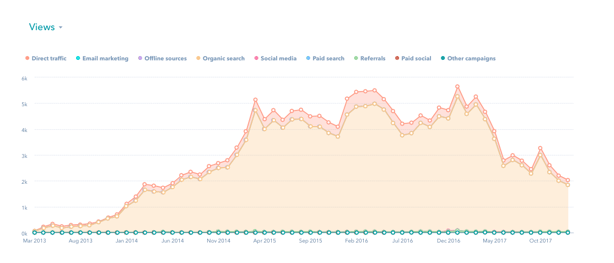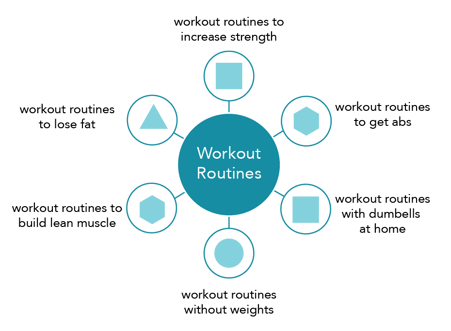Traffic vs. Conversion: Laser-Focused Marketing Tactics for Growth
Ultimately, we all need to drive more business — sales teams are always asking for more opportunities, and marketing needs to deliver. So, as a...
6 min read
 Kevin Page
:
Apr 19, 2018 2:40:39 PM
Kevin Page
:
Apr 19, 2018 2:40:39 PM

It's a generally accepted truth that if you want more traffic, you just need to create more content. More blogs and website pages mean more opportunities for people to find your website. But what if I told you that isn't true, that all more content really means is that you have more content.
More importantly, what if I told you that there was another way to boost your blog traffic? Spoiler alert, it’s all about auditing and optimizing your old content, and if you read ahead, I’ll explain how it helped us get more traffic while doing less writing.
I've seen the analytics for a lot of companies that publish a lot of content, and there's the consistent theme. If you write a lot of content, eventually you'll find a golden nugget. It's these magic bullet blog posts that keep us in the mindset that if we just keep writing more, eventually we will strike gold again. This mentality is an ever-lingering "best practice" from the early days of SEO.
One particular example sticks out in my mind. There was a company in the filtered water industry that had written hundreds of blogs and of all but one of the blogs they'd written had under 200 views. That one other blog post had more than 187,000 views. It outperformed the rest of their website combined.

The truth of the matter is that this method is a complete gamble. It's possible that you could write thousands of other blog posts and never write anything that reaches this level of success.
The truth is that we are all competing for the same spaces on the internet, and your only option is to be better than your competition. So, it's not enough to write a semi-interesting, 400-word blog post that doesn't help answer your customers' questions. Creating long-form, in-depth content can feel daunting, but if you already have a library of blog content, then you probably have the tools you need to get started right away.
Here are some steps you can follow that will help you take your content from no man's land to a thriving hub that drives new traffic:
Believe it or not, your collection of underperforming blog posts can actually hurt your website traffic. Think of it like a layer of dust in your attic that makes it harder for search engines to understand what's valuable and what's trash.
The first step in your content spring cleaning is to look at your least successful blog posts. I know that seems counter-intuitive but stick with me. Spend some time looking at your analytics to see which posts have driven the smallest number of views in the last 12 months, especially keep an eye out for ones that have had no views at all.
Once you've vetted through your blogs, don't be afraid to unpublish blogs that bring little value. Old announcements, outdated services, etc. Just get rid of them. You CAN delete blog posts. It's OK. Just make sure that you are creating the right redirects and saving any content that might be useful in another post.
In fact, there are many companies and bloggers (StoryTeller included) that have found deleting old blog posts has helped create a clearer picture of what your website content has to offer.
The second step is to look at all the posts that are targeting the exact same keywords. If you are like most companies, you probably have over 20 blogs that all use the exact keyword phrase for your core products and services.
Most of the time, this is hurting your results rather than helping. In a lot of cases, search engines don't have any signals from your website or external sources that help them understand which of your posts are the most relevant to a certain topic.
Search within your blog tool or use the site search function in Google to identify blogs that are written on the exact same topics.

Take inventory of every blog on each topic and group similar content together. In some instances, this might be broader topics that use different keyword phrases, like every post that talks about calculating the cost or pricing of your service. For others, it might be literally blogs that use the exact same keyword phrase. Most likely, your old content will have a combination of both.
Use a spreadsheet and organize your blogs by keyword/topic and then include links to every blog post that matches this topic below as well as the total number of views to this blog and if it has internal links or external links. Once you've categorized all of your similar blog posts, you can use the strategies below to improve this content to drive more results.
Take a look at the list of blogs you've compiled. Analyze the results to determine which post has the most value to Google right now. Generally speaking, this will be the post with higher views and more external links. While the internal links matter, it's easier for us to update those to help with our new posts moving forward.
Use your judgement to choose the best blog, but know there might not be a "right" answer. Sometimes, you could make an argument for multiple blogs. Don't spend too much time overthinking it.
Start with a single blog post. Look at all the other blogs that you have under the same topic and add in any relevant, helpful, or missing data. You may have to rework the structure to make them all work together.
Once you've updated the content, don't be afraid to rework your title and URL to better match the new content. It can be helpful to change your URL to simply be "yourdomain.com/keyword-phrase." Not only does this help give a very clear keyword signal to search engines, but it makes it easier for you to update the title in the future as your content evolves. As an added bonus, it will help stop you from creating more duplicate content in the future.
Once your updated content is live, unpublish your other contributing blogs and redirect them to your new updated blog post. Make sure to update those other posts that had the old links to them, as well.
Content pillars are the best way to combine all of your knowledge on a single topic into an all-in-one resource that attracts and educates your target audience. The basic idea is that by combining high-level information about a topic on one page and then linking out to longer, more in-depth articles on each subtopic, you can create an ultra-useful guide that works both for search engines and real people.

We've written a lot about how and why to create content pillars on our blog before, so we won't go into super specific detail in this post, but you can check out our other posts if you need more info.
This is an important step in the process that a lot of people miss. Search engines use your internal linking structure as a key way to understand how your content fits together. Once you've finished updating a piece of content, go back and do another site search of your website. Type into the Google search bar "site:yourwebsite.com" and "your keyword phrase." Look for all the instances on your website where you use that phrase and make sure it links to your updated blog post.
Basically, this is telling search engines, "Hey! See this page? Any time someone searches for 'your keyword phrase,' this is the right page to show them on my site."
That's good, we want that.
Now that your website clearly points people to the right place for each keyword term, the only way to keep increasing the reputability of that page is by having other websites validate that this is a valuable resource for a specific search term.
Set aside time to do guest blogging or reach out to other partners to try to get more links to your site. The more links to a single page, the better. This is a time-consuming process, but it WILL help your results.
There are a lot of strategies out there about how to get new backlinks. Once you are ready for this step in the process, check out resources detailing the skyscraper technique, broken link building, and guest blogging as strategies to build your backlinks.
So, the truth of the matter is that this strategy still takes a lot of work. But our organic blog traffic has more than doubled as a result of doing this kind of work on our own blog. Remember to keep an eye on your data and look for signs that your blogs are starting to perform better. It might take several iterations to get your blog performing how you'd like it to.
Content in the digital world is never done. Just keep making it better, more helpful, and more strategic.

Ultimately, we all need to drive more business — sales teams are always asking for more opportunities, and marketing needs to deliver. So, as a...

More blog traffic — a dream for all inbound and content marketers, right? Unfortunately, there is no magic formula for driving more viewers to your...

Most marketers struggle to increase traffic to their websites, as there are a lot of ways to get from "point A to point B."